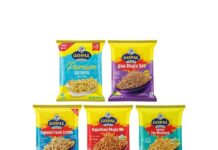
As India intensifies efforts to fight hunger and malnutrition, the Tata-Cornell Institute (TCI) and ICRISAT are helping policymakers with evidence-based strategies to include millet in the Public Distribution System (PDS) which provides food subsidies to low-income families.
Known as ‘Smart Foods,’ millets are globally celebrated for being nutrient-rich and climate-resilient. Alongside staples like rice and wheat, they provide important benefits for food security and nutrition, yet their inclusion in the PDS remains largely underutilized.
To advance solutions, a TCI forum on ‘Promoting Millets in the PDS’ was hosted at ICRISAT’s Hyderabad campus, bringing together key participants from across the country.
The event featured an opening address by Dr Prabhu Pingali, ICRISAT Board Chair and Director of the Tata-Cornell Institute.
Professor Prabhu Pingali said that novel insights were leading to reforms, helping to pave the way for a more effective and future-ready Public Distribution System in India.
“Millets can reshape our food systems, but only if we align policy, science, and action toward that goal.’ “In response, the TCI is working with its partners to decode the ‘true cost of the PDS’—considering its environmental, economic, and nutritional impacts and to assess untapped opportunities for improvement.
“For example, by enabling states to source locally grown millets through the work of ICRISAT and its partners, we’re not just supporting farmers — we are strengthening the PDS to provide healthier more sustainable food for the most economically vulnerable.
“Modernizing the system through the decentralization of food procurement, the introduction of digitized ration cards, and streamlined supply chains are moves that will mean less leakage of PDS food grains and more accountability.
“With the potential of cash-based vouchers, families can gain the freedom to choose the nutritious foods they need, such as millet, rather than being limited to fixed staples, increasing demand for these nutritious grains and sending a strong price signal to millet producers to increase supply,” said Dr Pingali.
Through its project on the true cost of food subsidies in India, TCI has estimated the hidden costs associated with the PDS.
In a study published in Environmental Research Letters, researchers show that the true cost of the PDS in 2021-22 was US$45.3 billion when the economic and environmental impacts of rice and wheat production were considered, compared with US$16.5 billion budgeted by the federal government.
They further demonstrated that replacing 1 kilogram of rice with millets for 200 million PDS beneficiaries would shrink the program’s true cost by US$1.37 billion each year.
Dr Stanford Blade, director general-Interim, ICRISAT, emphasized the need to build on the momentum created by the International Year of Millets-2023 and ICRISAT’s Smart Food campaign.
“With the conclusion of the International Year of Millets, attention now turns to the question: what’s next?
‘While millets have gained popularity among affluent consumers, ICRISAT is focused on ensuring their benefits reach those who need them most.
“This discussion is crucial for integrating millets into the Public Distribution System and avoiding the exclusivity that occurred with quinoa,’ said Dr. Blade.”
The learnings from the forum will contribute to a forthcoming book, Future Pathways for India’s Public Distribution System, being developed by TCI and ICRISAT. This book will complete the trilogy of books – Transforming Food Systems for a Rising India (downloaded 208000 times) and The Future of India’s Social Safety Nets.
IndiFoodBev — authentic, impactful and influential
An English-language food and beverage processing and packaging industry B2B platform in print and web, IndiFoodBev is in its third year of publication. It is said that the Indian food and beverage industries represent approximately US$ 900 billion in revenues which implies more than 20% of the country’s GDP. Eliminating the wastage on the farmside can help to deliver more protein to a higher number of the population apart from generating sizable exports. The savings in soil, seeds, water, fertilizer, energy and ultimately food and nutrition could be the most immense contribution that country is poised to make to the moderation of climate change.
To improve your marketing and grow sales to the food and beverage processing and packaging industry, talk to us. Our research and consulting company IppStar [www.ippstar.org] can assess your potential and addressable markets in light of the competition. We can discuss marketing, communication, and sales strategies for market entry and growth.
Suppliers and service providers with a strategy and budget for targeted marketing can discuss using our hybrid print, web, video, and social media channels to create brand recognition linked to market relevance. Our technical writers are ready to meet you and your customers for content.
The second largest producer of fruit and vegetables in the world is continuously expanding processing capacities and delivery systems with appropriate innovative technologies. We cover product and consumer trends, nutrition, processing, research, equipment and packaging from farm to thali. Get our 2025 media kit and recalibrate your role in this dynamic market. Enhance your visibility and relevance to existing markets and turn potential customers into conversations. Ask for a sample copy of our bi-monthly in print or our weekly IndiFoodBev eZine each Wednesday.
For editorial info@ippgroup.in — for advertisement ads1@ippgroup.in and for subscriptions subscription@ippgroup.in
Naresh Khanna – 10 February 2025
Subscribe Now










